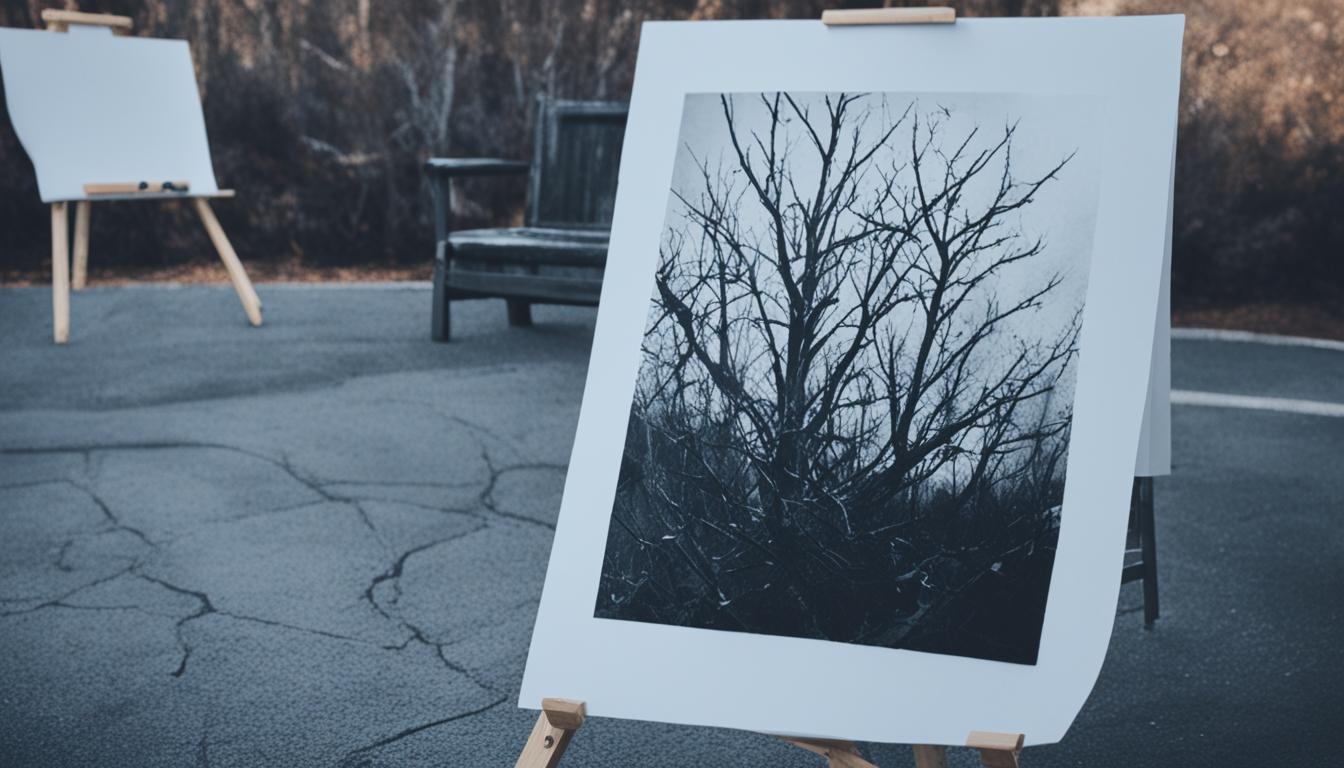Welcome to our guide on navigating ethical considerations in fine art photography. As photographers, it is essential for us to uphold ethical practices and maintain artistic integrity in our work. Fine art photography has the power to capture emotions, unveil realities, and provoke thought. However, it also has the potential to distort truth and exploit subjects if we overlook ethical considerations.
When it comes to ethical photography, there are certain principles and standards that we should adhere to. In the realm of pure photography, our responsibility is to stay true to the subject and represent it honestly. This requires us to be authentic and transparent in our representation, ensuring that what was captured on film is faithfully presented.
However, ethical considerations extend beyond pure photography. Different genres of photography, such as composite photography and advertising photography, come with their own set of ethics. Composite photography involves merging multiple images to create a new composition, and it is crucial to respect intellectual property rights and avoid misleading or misrepresenting the final image. In advertising photography, ethical dilemmas may arise when presenting products or services in a way that is deceptive or harmful.
By taking ethical considerations seriously, not only do we reflect positively on ourselves as photographers, but we also contribute to a healthier and more respectful industry. In this guide, we will explore various aspects of ethical considerations in art, including cultural context, environmental impact, artistic plagiarism, and intellectual property rights. Together, let’s embrace ethical practices in our art and create work that is not only visually captivating but also ethically sound.
Key Takeaways:
- Ethics are important in maintaining artistic integrity in fine art photography.
- Staying true to the subject and representing it honestly is crucial in maintaining ethical standards.
- Different genres of photography have their own ethical considerations.
- Other ethical considerations include fair pricing, respecting intellectual property rights, and avoiding misrepresentations in advertising photography.
- Taking ethical considerations seriously contributes to a healthier and more respectful industry.
What are Ethical Considerations in Art?
In the world of art, ethical considerations play a crucial role in shaping our creative practices. From respecting cultural context to addressing controversial themes, artists have a responsibility to uphold ethical standards in their work. In this section, we will explore the various aspects of ethical considerations in art and their significance.
Respecting Cultural Context
One of the fundamental ethical considerations in art involves respecting cultural context. It is important for artists to understand and honor the cultural heritage of the symbols, styles, and themes they incorporate into their artwork. This means not using cultural elements in a way that may disrespect or exploit the culture they originate from. By acknowledging the historical and social significance of these elements, artists can create art that appreciates and celebrates diverse cultures.
Considering Environmental Impact
In today’s world, environmental sustainability is a pressing concern. Artists can contribute to a greener future by considering the environmental impact of their art practices. This involves using eco-friendly materials, such as recycled or biodegradable options, and minimizing waste through practices like recycling and resource conservation. By making conscious choices, artists can use their creativity to promote a more sustainable and environmentally conscious art industry.
Avoiding Artistic Plagiarism
Artistic plagiarism is a serious ethical concern in the art world. It involves copying another artist’s work or ideas without permission or proper acknowledgment. Artists must strive for originality by developing their own unique style and exploring different techniques and mediums. Giving credit to other artists when appropriate is essential in avoiding plagiarism and maintaining artistic integrity. By respecting the creative contributions of others, artists contribute to a culture of authenticity and innovation.
Handling Controversial Themes
Art has the power to provoke, challenge, and engage with controversial themes. When addressing such topics, ethical considerations become crucial. Artists should approach controversial themes with sensitivity, respect, and a genuine intention to contribute to the conversation. By engaging in thoughtful dialogue and considering diverse perspectives, artists can bring about social awareness and foster understanding.
Respecting Intellectual Property Rights
Respecting intellectual property rights is another important ethical consideration in the art world. Artists should recognize and respect the legal rights of other artists to their work. This means not reproducing or using someone else’s work without proper permission or attribution. By upholding intellectual property rights, artists protect their own creations and contribute to a fair and respectful art community.
By embracing these ethical considerations, artists can create responsibly and contribute to a more respectful and understanding art industry. These considerations not only shape the quality and impact of our art, but also reflect our values as artists and members of a global creative society.
How to Respect Cultural Context in Art
Respecting cultural context in art is essential to honor the rich cultural heritage and diversity of symbols, styles, and themes used in artwork. As artists, it is our responsibility to approach cultural elements with sensitivity and respect, ensuring that our work accurately represents the cultures we draw inspiration from.
One crucial step in respecting cultural context is conducting thorough research. By delving into the history, significance, and traditions associated with the cultural elements we incorporate into our art, we gain a deeper understanding of their meaning and context. This research allows us to create work that accurately reflects the cultural heritage we seek to honor.
Furthermore, seeking consent from individuals from the culture being represented adds an extra layer of respect and collaboration. Engaging in conversations with community members helps us understand cultural nuances, ensuring that our art is informed by the perspectives and insights of those who call the culture their own.
When creating art that draws inspiration from different cultures, it is important to acknowledge and give credit to the sources of our inspiration. By acknowledging the cultural contributions that inspire our work, we demonstrate our respect for the traditions and individuals who have shaped the artistic landscape.
Artists should also be sensitive and considerate when using cultural symbols, avoiding stereotypes and misrepresentations. By representing cultural elements authentically and respectfully, we can foster understanding and appreciation for diverse cultures.
Art has the power to educate and transcend barriers, and it can be a platform for sharing stories, significance, and values behind cultural elements. By using art as a medium to educate others about different cultures, we contribute to a more inclusive and culturally aware society.
Together, let’s strive to create art that respects and appreciates diverse cultures while allowing our creativity to thrive.

Key Takeaways:
- Respecting cultural context in art involves conducting research and understanding the history, significance, and traditions associated with cultural elements.
- Seeking consent from individuals from the culture being represented adds respect and enriches our understanding.
- Giving credit to sources of inspiration acknowledges the cultural contributions and traditions that shape our artwork.
- Artists should be sensitive and avoid stereotypes or misrepresentations when using cultural symbols.
- Art can be used as a platform to educate others about different cultures and foster inclusivity.
Tips to Avoid Artistic Plagiarism
Artistic plagiarism is the act of copying another artist’s work or ideas without permission or proper acknowledgment. It is considered unethical and can harm both the original artist and the integrity of the art community. To maintain originality and uphold ethical practices in art, here are some tips to avoid artistic plagiarism:
- Develop your own unique style: Strive to cultivate a distinct artistic style that reflects your individuality. Experiment with different techniques, mediums, and concepts to create something truly original.
- Give credit where it’s due: If you draw inspiration from another artist’s work, make sure to give credit. Acknowledging their influence not only demonstrates respect but also helps establish authenticity in your own creations.
- Seek permission when necessary: If you plan to incorporate a significant part of another artist’s work or design into your own, it’s best to obtain permission beforehand. This extends professional courtesy and ensures that proper credit is given.
- Reflect on your intentions: Take a moment to reflect on your intentions as an artist and ensure that your work aligns with your personal values and the principles of ethical art. This self-reflection can guide you in creating original and meaningful pieces.
Remember, avoiding artistic plagiarism not only protects your own creative integrity but also fosters a more respectful and honest art community.
Developing a Unique Style
Developing a unique artistic style is an essential aspect of avoiding artistic plagiarism. It involves exploring different artistic techniques, mediums, and concepts to create something that is distinctly yours. By infusing your work with originality and personal expression, you can establish your own artistic identity.
While drawing inspiration from other artists is natural and can fuel your creative growth, it is crucial to balance that inspiration with originality. Creating a unique style requires experimentation, constant learning, and pushing the boundaries of your creative capabilities. Trust your instincts, embrace your individuality, and let your artwork speak with your voice.
Seeking Permission and Giving Credit
Respect for fellow artists and their work is a fundamental principle of ethical art. When you find inspiration in another artist’s work, it is important to give credit where it’s due. This can be done through proper citation, acknowledgment, or referencing in your artwork or accompanying descriptions.
If you plan to use a significant portion of another artist’s work or design, seeking permission is essential. By obtaining the artist’s consent, you demonstrate professionalism and ensure that appropriate credit is given. This practice not only protects the original artist’s rights but also promotes an atmosphere of mutual respect within the art community.
How to Consider Environmental Impact in Art Practices
As artists, we have the power to make conscious choices that consider the environmental impact of our art practices. By adopting eco-friendly and sustainable approaches, we can create beautiful works of art while minimizing harm to the environment.
One way to prioritize the environment is by selecting materials that are both eco-friendly and non-toxic. Opt for biodegradable materials that can easily break down without leaving a lasting negative impact. This not only protects the environment but also ensures the safety of the artists and viewers.
“Artists should strive to create a positive impact on the environment by using sustainable materials and techniques.”
Recycling and reusing materials is another effective way to reduce waste and minimize our footprint. By repurposing items in our art, we can breathe new life into discarded materials and explore unique creative possibilities.
Conserving resources is vital in sustainable art practices. Being mindful of resource consumption, such as water and electricity usage, can make a substantial difference. Simple adjustments, such as turning off lights when not in use, or using water sparingly during the creative process, can contribute to a more sustainable approach.
Planning our projects is another essential aspect of reducing waste and overbuying materials. By carefully considering our project requirements, we can avoid excessive purchases and use materials more efficiently, resulting in a more sustainable art practice.
Proper disposal of art materials is crucial to minimize environmental impact. Some art materials, such as certain paints and solvents, can be harmful if not disposed of properly. It’s important to research the correct methods of disposal to ensure that these materials do not negatively impact the environment.
Eco-friendly Art Materials Comparison
| Material | Advantages | Disadvantages |
|---|---|---|
| Recycled paper | Reduces deforestation, requires less energy to produce | May have limited color options, may have texture variations |
| Water-based paints | Non-toxic, easier to clean, fewer harmful emissions | May require more layers for desired opacity |
| Bamboo brushes | Renewable, lightweight, durable | May have limited availability, initial cost may be higher |
| Recycled canvas | Reduces waste, maintains quality | May have limited size options, texture variations |
By considering the environmental consequences of our art practices, we can contribute to a more sustainable future while creating meaningful and impactful art. Let’s embrace eco-friendly materials, recycle and conserve resources, and dispose of art materials responsibly. Together, we can make a positive difference in our artistic journey and in the world around us.
Conclusion
As photographers and artists, it is important for us to navigate ethical considerations in our fine art practices. By making conscious choices that uphold artistic integrity and respect for our subjects, viewers, and industry, we can create responsible and meaningful art.
Understanding and following ethical guidelines, such as staying true to the subject and being authentic and honest in representation, are essential in maintaining the integrity of our photography. We must also respect cultural context, avoiding artistic plagiarism, considering environmental impact, and addressing controversial themes. These considerations contribute to creating art that is respectful, valuable, and mindful of the impact it has on individuals, cultures, and the environment.
By practicing ethically, we not only enhance our professional reputation but also foster a healthier and more respectful industry. Our photography has the power to reflect our values and contribute positively to the art community. Let us continue to strive for responsible art, always mindful of the importance of ethical practices and the impact they have on the world around us.
FAQ
What are the ethical considerations in fine art photography?
Ethical considerations in fine art photography include maintaining artistic integrity, staying true to the subject, respecting individuals’ privacy, avoiding plagiarism, being authentic and honest in representation, and following photography standards.
What are the ethical considerations in art?
Ethical considerations in art encompass respecting cultural context, considering environmental impact, avoiding artistic plagiarism, addressing controversial themes, and respecting intellectual property rights.
How can I respect cultural context in art?
To respect cultural context in art, conduct research on the cultural heritage of symbols, styles, and themes, seek consent from individuals from the culture being represented, give credit to sources of inspiration, and avoid stereotypes or misrepresentations.
What tips can I follow to avoid artistic plagiarism?
To avoid artistic plagiarism, strive for originality, give credit to other artists, seek permission if using a significant part of another artist’s work or design, and reflect on your intentions as an artist to align with ethical principles.
How can I consider environmental impact in my art practices?
Consider environmental impact by using eco-friendly and non-toxic materials, recycling and reusing materials, conserving resources like water and electricity, planning projects to reduce waste, and disposing of materials responsibly.
Why is it important to navigate ethical considerations in fine art photography?
Navigating ethical considerations in fine art photography helps uphold artistic integrity, respect for subjects and viewers, and contributes to a healthier and more respectful industry.
How can I maintain artistic integrity in my photography?
To maintain artistic integrity, stay true to the subject, be authentic and honest in representation, respect individuals’ privacy, avoid plagiarism, and follow photography standards.
What are the benefits of practicing ethical photography?
Practicing ethical photography enhances professional reputation, fosters a healthier and more respectful industry, and allows photographers to create art that reflects their values and contributes positively to the art community.
How to Ensure Ethical Considerations are Addressed in the Fine Art Photography Market?
When navigating the fine art photography market, it’s crucial to prioritize ethical considerations. Always obtain proper permissions, crediting artists and respecting their intellectual property rights. Additionally, be mindful of cultural sensitivities and avoid exploitation. These fine art photography market tips will help ensure ethical practices are upheld.




